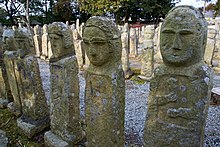Kibi (Kingdom)
Kibi ( Japanese 吉 備 国 , Kibi no kuni ) was an ancient kingdom in western Japan . It extended over what are now the prefectures of Okayama , Hiroshima and Hyōgo . After some time it was incorporated into the ambitious Yamato empire and converted into a province.
In the second half of the 7th century, the province was split into the provinces of Bizen ("Front Kibi"), Bitchū ("Middle Kibi") and Bingo ("Rear Kibi"). These were collectively referred to as Bishū ( 備 州 , "Kibi province (s)").
Origin of name
The oldest mention of Kibi can be found in the Imperial Chronicle Kojiki from 712 when describing the genesis of the Japanese islands, although the meaning of the name is unknown.
One theory suggests that the word 黍 ( kibi) means millet .
origin
The origin of the kibi population is disputed. Japanese chronicles always mention that the culture and customs of the Kibi are different from that of the Japanese (Yamato).
Some archaeological finds indicate a Central Asian people who immigrated to Japan or influenced the Japanese of the region. Most historians assume that the Kibi population was Japanese, but that the Kibi royal family did not have Japanese mercenaries in their service and that these are to be honored with statues (called Kasai Rakan). These statues are similar to war memorials of the Scythians , an Indo-European people. This custom was adopted by other Siberian peoples and possibly ended up in Japan - Kibi. But they can also simply be imported statues or imported artists. In any case, genetic analyzes of the historical Kibi population do not show any deviation from other Japanese and thus the immigration of another people is largely excluded.
history
Kibi was originally an independent kingdom and came under the control of the Yamato Empire (the later Japanese state) early on . Due to its position on the Seto Inland Sea , it probably controlled the trade routes between northern Kyushu and Kinki (the center of Yamato). In the area of Kibi there are a large number of Kofun ( Tumuli ), of which the Tsukuriyama Kofun ( 造 山 古墳 ) with 350-360 m in length protrudes as the fourth largest in Japan. This dates from the early 5th century, so that the size indicates a special position Kibi for this period, even if it was part of Yamato. However, there is also the thesis that Kibi was still a kingdom at this point in time (since the said Kofun is comparatively little mentioned in the imperial chronicles) and that the Kofun was thus a royal tomb.
Evidence of Kibi's importance in the fourth and fifth centuries is borne out by the hundreds of kofun found in the area. Even after the Kibi kingdom was subjugated, the descendants of the royal family ( Kibi clan ), such as Kibi no Makibi , remained very influential.
See also
Individual evidence
- ↑ 吉 備 . In: 世界 大 百科 事 典 第 2 版 at kotobank.jp. Retrieved May 20, 2013 (Japanese).
- ^ The historical reach of the Saka-Kambuja Scythians, and their influences upon Gaya kingdom and Kofun-and-postt-Kofun-era-Japan . In: JAPANESE MYTHOLOGY & FOLKLORE . February 27, 2013 ( wordpress.com [accessed September 11, 2018]).
- ^ Mark A. Riddle (2011): "Turkic Balbal in Japan" Pleasant Grove, Utah
- ^ Mark J. Hudson: Ruins of Identity: Ethnogenesis in the Japanese Islands . University of Hawaii Press, 1999, ISBN 0-8248-2156-4 , pp. 188 ( limited preview in Google Book search).
- ↑ J. Edward Kidder, Jr .: Himiko and Japan's Elusive Chiefdom of Yamatai: Archeology, History, and Mythology . University of Hawaii Press, 2007, ISBN 978-0-8248-3035-9 , pp. 162 ( limited preview in Google Book search).
- ↑ 造 山 古墳 . In: 国 指定 史跡 完全 ガ イ ド at kotobank.jp. Retrieved May 20, 2013 (Japanese).


